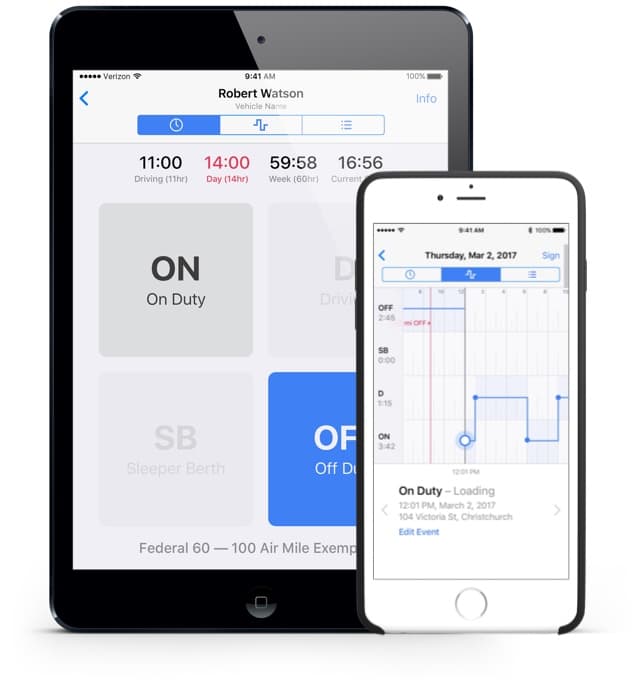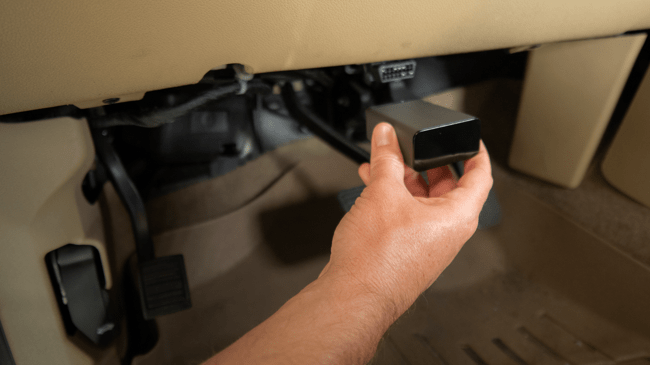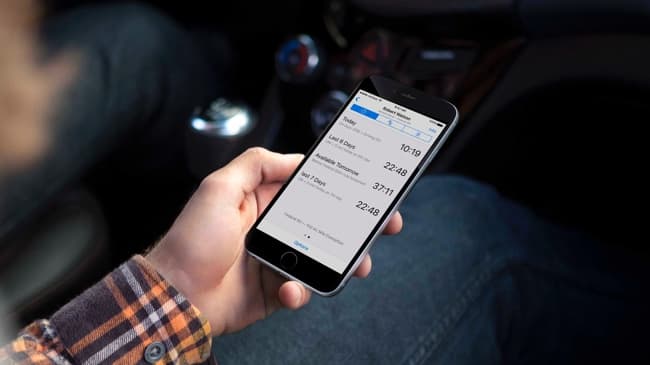The Electronic Logging Device (ELD) Mandate
The ELD Mandate came into effect on December 18, 2017, and required that all commercial vehicles will need to have an ELD fitted to replace the current paper log book system.*
For most drivers the biggest change will be switching from traditional paper logbooks to paperless logbooks. The standard driving requirements remain the same – except now it’s being recorded electronically, automatically in the background by a logbook app.


Electronic Logging Devices
An Electronic Logging Device (ELD) is comprised of two parts: the logging device (this is sometimes referred to as hardware; it is connected to the vehicle) and the reader (typically a mobile app) that connects to the hardware. The two work together to create the electronic logs.
Logging Device / Hardware
The logging device is wired to the truck (some makes such as Volvo, Mack or Hino include the hardware built-in) and logs vehicle activity including engine on and movement.
All commercial vehicles with an engine year of 2000 or later need to have a logging device fitted. There are a range of different hardware options available for aftermarket installations. Our sales team can help you find the best fit for your vehicles.
ELD Logbook Apps
Drivers can access the data recorded by the e-logging device using an ELD logbook app on their mobile phone or tablet. The app is available for both Apple (iPad/iPhone) or Android devices.
The app reads data from the logging device using Bluetooth or Wi-Fi (if the hardware is Wi-Fi enabled).

Electronic Logs
The Verizon Connect Logbook app reads from the logging device to generate the driving information that is used by inspection officers to check drivers are compliant with the driving hour regulations.
These electronic logs can be accessed by an officer using Bluetooth or email and detail driver status–driving, on duty, sleeping and off duty–over the last eight days. It also shows when the 34-hour restart was used and any HOS limits that have been exceeded.
These ELD electronic logs can also be accessed using your Verizon Connect fleet management software, which can be used by management or dispatch to review and allocate driver duties.
ELD mandate FAQs
As of December 18, 2017, all qualified drivers must log records of duty status (“RODS”) electronically. This replaced all existing paper logbooks used to record compliance with Hours of Service (“HOS”). To help you understand more about the Electronic Logging Device, (“ELD”) rule, we’ve compiled a list of frequently asked questions:
What Is The FMCSA ELD Rule?
The ELD Rule was published by the FMCSA (Federal Motor Carrier Safety Administration). It is part of an initiative to improve safety on the road, while insuring drivers keep total control over their own Hours of Service (HOS) records.
What this means:
- FOR EVERYONE - It mandates who must use an ELD and the timeframe for compliance
- FOR YOU - It outlines how a driver is empowered to keep and certify records to prevent harassment or coercion
- FOR US - It provides ELD solution providers with the technical specifications for how their products must operate to be compliant once the ELD Rule mandate is in effect
There’s a good chance if you keep HOS paper logs today, you’ll need to be compliant with the ELD Rule over time.
Does The ELD Mandate Apply To Me?
As a rule of thumb, those currently using paper logs for HOS should confirm with their governing DOT (Department of Transportation) if the rule applies and understand what it would take to get ELDs in place.
The ELD Rule applies to commercial interstate truckers and bus drivers who meet the requirements based on weight or activity to record duty status information.
There are some exemptions to the electronic log mandate, which include:
- Short haul drivers
- Drive away/tow away operations where the commercial motor vehicle being driven is the commodity
- Drivers that only keep logs for 8 days out of a 30 day period
- Drivers operating vehicles that are older than model year 2000
What Is An ELD or Electronic Logging Device?
An ELD is an electronic logging device used by drivers to create compliant records of duty status. In general, an ELD must be connected with a vehicle’s engine to automate driving status and give a driver the ability to keep their record of duty status (RODS) and easily supply such records to roadside inspectors.
REMEMBER: An ELD does not automatically report your information to the government. Records of duty status (RODS) will still be requested roadside or via standard auditing procedures at the terminal.
How Does The ELD Timeline Affect Me?
ELD compliance can be split into three phases:
PHASE 1 – AWARENESS & TRANSITION PHASE
This phase will last from February 16, 2016 through December 18, 2017. During this time, all carriers and drivers that are subject to the ELD Rule should prepare to comply and consider starting to use ELDs. During this time, however, driver and carriers can use paper logs, logging software or AOBRDs for their records of duty (RODS).
PHASE 2 – PHASED-IN COMPLIANCE PHASE
This phase runs from December 18, 2017 to December 16, 2019. During this time, drivers and carriers who are subject to the ELD Rule can use AOBRDs that were installed prior to December 18, 2017 or certified, registered ELDs. Paper logs will no longer be accepted.
PHASE 3 – FULL COMPLIANCE PHASE
After December 16, 2019 all drivers who are subject to the ELD Rule must be using certified, registered ELDs that comply with all ELD regulations.
What Are The Benefits Of Using ELDs?
ELDs can help a driver run e-logs in a much more compliant fashion. By using technology tied to the vehicle and following regulations, drivers can reduce three of the top five finable areas: not having logs, or out-of-date logs; driving hours over their daily allowance; and errors.
Logbook can give drivers peace of mind when driving up to an inspection and can get them in and out quickly, and without the potential risk of a fine. That will help reduce violation costs, saving money.
Why Should I Start Using An Electronic Logging System (ELD) Now?
- No more paperwork! Drivers save time every day with ELDs since they automate driving status and minimize support documentation requirements
- With most systems, including Logbook, dispatchers have near real-time visibility into location and can help improve estimated times of arrival to customer locations and dispatching decisions
- Like Logbook, ELDs that are integrated with vehicle tracking offer a wide range of safety and productivity features that go beyond basic compliance and can help create ROI (Returns on Investment).
How Much Will It Cost My Fleet To Be Compliant?
Cost and pricing model will vary by provider, depending on which components are included in an ongoing subscription and which components you own outright. For example:
- Some providers may give you the engine connectivity hardware and ongoing software as a subscription, but give you flexibility to buy the right devices for your drivers’ needs
-
Some providers may include the driver’s device for an upfront cost or in a higher pricing subscription, but this hardware is often proprietary with less flexibility of how it can be used beyond electronic logging
REMEMBER: You can turn the cost of compliance into a profit with the right ELD solution in place.
Do I Need To Have GPS Tracking To Be ELD Compliant?
To ultimately meet the ELD Rule specifications an ELD solution must provide automated, accurate location information at specified increments, which is best accomplished with a GPS-based solution.
Are Cell Phones Allowed To Be Used With ELDs?
Yes. The ELD Rule accommodates the use of smartphones and other wireless devices as ELDs. Logbook embraces this approach today by utilizing smart phones and tablets for driver interaction with hardware installed in the vehicle.
Why Is Logbook a Good Choice For An Electronic Logging Device Solution Provider?
We have years of experience delivering simple and effective solutions to help with compliance for drivers on the road as well as the team back at the home terminal.
Logbook is an add-on subscription to the Reveal vehicle tracking solution. Logbook includes the necessary engine connectivity hardware and installation into your vehicle. It also includes access to web-based software for your office team to view HOS driver status in near real-time along with compliance reporting and alerts.
Here is some information about our current Logbook solution:
- The design of Logbook is compliant with Federal 395.15 AOBRD regulations, which will remain in force until December 2019, which is the final ELD Rule compliance mandate deadline
- Logbook is designed with extensibility for future ELD Rule specifications well ahead of the compliance timing requirements with a simple software update for our Logbook users
- Our Logbook connects to a wide variety of mobile devices and works alongside our other mobile applications like the Reveal Field App to support capabilities like dispatching and navigation
- It minimizes upfront costs and helps ensure you remain compliant today and in the future
We know the value from exprience. Because this is important to you, it’s important to us. We are able to recognize how valuable an electronic logging device is to you because of our deep experience with thousands of vehicles over several years. Our mission is to keep our customers’ needs top of our mind to help ensure their operations are compliant and running smoothly.
Our Customers realize the benefits. Having an ELD solution in place can help improve overall compliance and administration. Drivers are able to know their time which prevents them from hitting a violation and solution administrators know which driver is able to take a load, as well as, when a violation happens. On top of that, an ELD solution provides opportunity to help reduce paperwork and increase productivity. That means no more file cabinets filled with countless sheets of paper!
We take it mobile. Our approach to electronic logs is delivered to drivers via mobile device, which is a big advantage for drivers. Our mobile app approach makes it easy to stay current with changing regulations, like ELD, on a platform your drivers already understand.
Where Can I Learn More About ELDs and the ELD Mandate?
Feel free to visit the official FMCSA resources on ELDs and the ELD Rule.
I’m Using Logbook Today. What Does The ELD Mandate Mean To Me?
If you are using Logbook today, the solution is compliant with Federal regulations. The good news is, you do not need to take any action at this time.
We will continue enhancing Logbook to be compliant with the ELD Rule specifications. When ready, we will register Logbook with the FMCSA as compliant and a simple app update will be available on your drivers’ mobile devices.
Using Logbook today gives you the security of using a compliant solution and the flexibility to seamlessly upgrade to the ELD regulations when your fleet is ready. What happens then? Your hardware will remain intact and we will help give you the tools and training necessary to transition your drivers and administration ahead of the mandate compliance deadline.
Can I Add More Logbook Units?
Yes. You can continue to use Logbook and add more units as desired. Our current Logbook solution is compliant and updates for the ELD Rule will NOT require you to change hardware later.
How Can I Get Employees On Board With ELD Compliance?
1. Select a GPS vehicle tracking provider whose product supports full Federal Motor Carrier Safety Administration (FMCSA) compliance. Choosing the right provider can make or break proper ELD compliance. Make sure that the provider is knowledgeable about how to support ELD regulations with an easy-to-use solution, and flexible, with tools that are easy to integrate/transition into your current operations (a learning curve is normal, but you shouldn’t need a Ph.D. to use something).
2. Help drivers understand the new tracking tools: As you roll out your new vehicle tracking system, make sure the drivers get that this new technology will help them maintain ELD compliance – it’s not just another of your wacky ideas (not that you’ve ever come up with a gem like Horse Boat or anything).
Your drivers will gain more control over their time, letting them create, edit and manage their own hours – plus, the tracking system gives them ways to help stay compliant, including Hours of Service (HOS) compliance tools; near real-time driver feedback; driver vehicle inspection reports; and IFTA mileage reporting.
For companies that can’t go beyond a certain mileage radius, tracking software’s geofencing capabilities help make it clear when drivers are going beyond the point they can be. And for companies worried about drivers putting in too many hours behind the wheel, features in the mobile app make it easy to calculate how many hours they have left for the day.
3. Implement an employee coaching program to increase engagement. The best way to maintain ELD compliance and help make your rollout a success is through effective and consistent driver coaching – your guys aren’t going to get better if they don’t know what they’re doing wrong.
Share both the good and not-so-good ELD compliance and GPS data, using reports, alerts and data entries that track driver behavior. The violation alerts and reports help managers monitor hourly infractions if they occur, meaning you can be all over any issues like white on rice before they turn into serious (and costly) problems. The near real-time data that is constantly pouring in from the tracking software lets managers to be proactive with instant, visible coachable moments.
4. Get employees on board to make your rollout a success. Don’t make ELD compliance sound like something they have to do because it helps the business – show drivers how it helps them, too, and they’ll be true believers.
The government is mandating electronic HOS compliance to improve safety, reduce risk, manage efficiency, rein in costs and increase overall regulatory compliance – but the one to focus on is safety: When they comply, it ensures they are alert and engaged behind the wheel, reducing the chance of accidents and other mishaps.
Keep the lines of communication open – your drivers may have questions on what they should or should not do – and develop clear written policies that people can reference if they have a question. Encourage people to give feedback on your policies – they might have an idea you didn’t think of.
Last but not least: Coach, encourage and repeat, and your company will be well on its way to compliance.
What Happens If I Am Not In Compliance?
If you drive for a living and disregard Federal Motor Carrier Safety Administration (FMCSA) regulations, Hazardous Materials regulations (HMR) or CDL regulations, well … what exactly does happen?
For starters, fines – and some of them are no joke; they can go into the tens of thousands. And it’s not just the driver who get the fine in many cases – it’s the owner of the vehicle, or the business, that also gets dinged.
In the case of CDL violations, including careless driving or speeding, drivers may have their license suspended or revoked. For a business, that could mean the loss of an employee.
And don’t forget that a business’s insurance can go up if the insurer deems the business a liability due to excessive tickets or fines – so it’s not just a one-time fee to pay; it’s higher costs over time, too.
If you’re curious just how high the fines can be, you can get more info on FMSCA fines, HMR fines and CDL fines. And if you’re curious on how you can be confident the business isn’t risking pricey fines and higher insurance costs, it might be time to investigate GPS vehicle tracking.
With near real-time fleet monitoring, management knows what’s going on in the field as it’s happening, meaning problems like speeding or aggressive driving can be nipped in the bud.
A vehicle tracking solution also helps keep track near real-time hours of service (HOS) and sends that information to the office, letting managers alert drivers to help prevent violations before they run out of hours.
Get a free demo
Within 15 minutes we will show you how our platform can best fit your business objectives.




